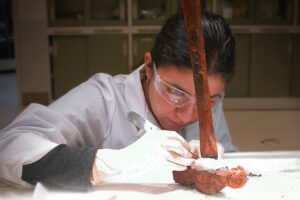Finding Could Prove Vital in Solving the Mystery of the Hunley’s Disappearance
Scientists have found evidence that the forward conning tower hatch, one of the two places where the crew could enter and exit the submarine, may have been intentionally opened. The discovery could prove to be a vital clue for scientists who are working to solve the century-old mystery of the Hunley’s disappearance.
Although thick concretion covers the forward conning tower, x-rays reveal the hatch is slightly ajar, separated from the tower by about a half-inch. The hatch had a locking mechanism that kept the door to the submarine closed and watertight. Recently, scientists found concreted iron rods at the bottom of Hunley commander Lt. George Dixon’s station that they think may be the remnants of that lock.
“The position of the lock could prove to be the most important clue we have uncovered yet and offers important insight into the possibilities surrounding the final moments before the submarine vanished that night,” said Hunley Commission Chairman Glenn McConnell.
If the rods prove to be part of the lock, it could mean damage happened to the forward conning tower shortly after the submarine’s attack on the Housatonic, that Dixon attempted to open the hatch, or he left it unlocked for a purpose.
If Dixon unlocked the hatch, there are several theories that could explain his action. After the Hunley sank the USS Housatonic, Dixon may have opened the hatch to determine if the explosion harmed the submarine or he may have left if unlocked so he could easily refresh the air supply within the crew compartment as they patiently waited for the change of tide. An unlocked hatch could also mean the men were trying to get out because of an emergency. But if they were trying to quickly escape, the men seated in the back would have attempted to open the aft hatch, their only way out of the submarine. Since the aft conning tower was found perfectly sealed, with its locking mechanism in place, this theory seems less likely.
“If the Hunley crew opened the hatch, it must have been for a critical reason. Even on a calm day, three-foot swells can occur out of nowhere on the waters off Charleston. Every time the hatch was opened, the crew ran the deadly risk of getting swamped,” Hunley Archaeologist Michael Scafuri said.
No matter what the cause, one thing remains clear: If Dixon unlocked the hatch, something stopped him from locking it.
An important reason to open the hatch could have been to signal success. If the Hunley crew accomplished their mission, historical records indicate the prearranged signal was to shine a blue light. Once those waiting for the submarine’s return on shore recognized the signal, they would light a fire to guide the crew back to Sullivan’s Island.
Union and Confederate historical records include eyewitness accounts of seeing a light, suggesting the Hunley could have survived immediately following its history-making attack. One sailor’s account states he saw a blue light in front of the USS Canandaigua, the first Union ships to arrive at the Housatonic wreck to help pick up survivors. If the testimony is accurate, the Hunley could have been directly in the Canandaigua’s path, which may have caused fatal results for the submarine’s crew.
In the rush to reach the Housatonic, the Canandaigua could have either struck the Hunley while at full speed or its wake swamped the submarine while the hatch was still open.
If the crew did not unlock the hatch to signal to land, the opening could have been caused by other events that occurred during the 136 years the Hunley rested on the ocean floor. The lock may have eroded, causing the hatch to open slightly over time. Another possibility is the damage was caused by those who sought to find the legendary submarine.
The Hunley’s accomplishment changed naval warfare for all time, a fact that did not escape the Union. In November, 1864, the United States Navy sent an expedition to drag the ocean floor around the wreck of the Housatonic in search of the submarine that had caused one of the best ships in their fleet to sink. Once the Hunley is deconcreted and its surface exposed, scientists may find indications that the damage to the submarine was caused by the dragging.
The archaeological team plans to create various modeling scenarios to reconstruct the events of the Hunley’s historic mission. The position of the forward hatch and its lock is one of the many clues scientists will need to investigate as they try to understand what caused the Hunley to vanish.
Friends of the Hunley
On the evening of February 17, 1864, the H. L. Hunley became the world’s first successful combat submarine by sinking the USS Housatonic. After signaling to shore that the mission had been accomplished, the submarine and her crew of eight vanished. Lost at sea for over a century, the Hunley was located in 1995 by Clive Cussler’s National Underwater Marine Agency (NUMA). The hand-cranked vessel was raised in 2000 and delivered to the Warren Lasch Conservation Center, where an international team of scientists are at work conserving the vessel and piecing together clues to solve the mystery of her disappearance. This material is based upon work assisted by a grant from the Department of the Interior, National Park Service.


